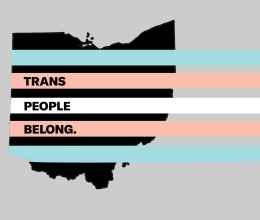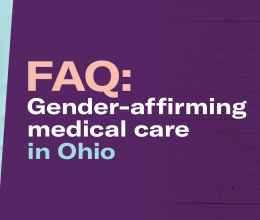On December 28, 2014, Leelah Alcorn walked four miles from her home in King Mills, Ohio, before walking onto Interstate 71 and being struck by a tractor-trailer around 2:30 in the morning. She was seventeen years old. In a suicide note posted on Leelah’s Tumblr, she wrote about her family’s refusal to accept her gender identity when she came out as trans. She pleaded, “The only way I will rest in peace is if one day transgender people aren’t treated the way I was… My death needs to mean something.” Leelah’s story is a powerful testament to the absolute necessity of gender-affirming care for youth in Ohio and across the nation. Despite this, the culture war against our trans communities’ rages on eight years later. Hundreds of anti-trans bills have been proposed across the nation in 2022 alone. In March of this year, Texas Governor Greg Abbott ordered state child welfare officials to launch abuse investigations into reports of trans youth receiving gender-affirming healthcare. In May, Alabama became the first state in U.S. history to make gender-affirming healthcare a felony.
Ohio, like many other states, has followed suit. House Bill 454 (The SAFE Act) aims to ban affirming care for youth altogether. This bill, introduced by Representatives Click and Grendell, directly contradicts best practice medical guidelines. The American Academy of Pediatricians and the Endocrine Society recommend gender-affirming care for transgender youth, and the American Academy of Child and Adolescent Psychiatry and the American Psychiatric Association view this care as evidence-based practice. Gender-affirming care is correlated with significantly lower rates of suicidality and suicide attempts for transgender and gender non-conforming youth. Despite this overwhelming evidence in support of treatment, Ohio joined the ranks of misguided states aiming to make it illegal. This unprecedented violation of family autonomy begs the question: Why is an evidence-based medical practice met with such sudden and severe resistance by lawmakers?
The answer is complex, but we can begin to understand aversion towards gender-affirming care by reflecting upon the ways in which trans people have historically been represented in the media and those who personally knows someone who is transgender. Overall, four in ten Americans personally know someone who is transgender. However, the average age range for those individuals is 18 to 49 years old. That leaves many people off the list of those who typically identify as knowing someone who is transgender. We know that personal knowledge of the trans community is a key factor in supporting non-discriminatory policy. For folks without personal knowledge or experience, most fall back on information they’ve learned from the media, which has a dark history of sensationalizing trans surgery stories and misrepresenting what it is to be transgender. More often than not, movies and news stories that highlight the trans community perpetuate stereotypes that trans people are confused and comical. Most media promotes surgical intervention as the lynch pin of transness.
Reflecting upon the historically negative and erroneous media exposure that trans people receive, it makes sense why many people correlate being trans with life-altering surgeries. We are fed a fallacy that all trans people alter their bodies through significant surgical procedures, that most do so on a whim; however, this portrayal of what it is to be trans could not be further from the truth. The trans identity is vast. Surgical and medical interventions are not requirements of being transgender, but they should be supported. Many forego medical interventions and simply seek a social transition: a new name, different pronouns, and clothing that better suit their identity. For those that choose to seek medical intervention, they engage with multiple clinical professionals to ensure safe and informed decisions. They may choose to proceed with surgery, or they may simply be prescribed hormones. The process oftentimes takes years and is backed by major medical organizations including the American Academy of Pediatricians, the Endocrine Society, the American Academy of Child and Adolescent Psychiatry, and the American Psychiatric Association. The average time span between a person's realization of their trans identity and verbalization of their trans identity is seven and a half years.
The false notion that being trans necessitates immediate surgical intervention is a major argument against gender-affirming care for youth. Some believe children who question their gender are brought into a doctor’s office and immediately offered these permanent, life-altering medical interventions. The reality is that emotional and social support, not medical or surgical intervention, are the cornerstones of care for trans youth. A social transition must be in place for a consistent duration of time, oftentimes for years, prior to the exploration of any form of medical intervention. Even when medical intervention is deemed necessary, the most common form of intervention for youth is temporary and its effects entirely reversible. Puberty blockers are a safe and effective medication that temporarily delay the onset of puberty, allowing a child more time to explore their identity before their body changes in ways that could significantly increase their chances of suicide. Contrary to the bill sponsors’ claims that this intervention is experimental, puberty blockers have been approved by the FDA since 1993.
Hormone replacement therapy (HRT) is an additional medical intervention that may be prescribed to teenagers; however, the requirements are more stringent. There must be a demonstrated history of insistent, persistent, and consistent gender dysphoria. Many doctors require that teens are in therapy prior to this decision, and many doctors require a letter from the teen’s clinician prior to prescribing hormones. The decision to be placed on hormones is one that requires years of documented gender dysphoria and the review of multiple medical professionals before it is approved. For those that are prescribed HRT, the effects are semi-permanent but the changes are slow. It takes years for secondary sex characteristics to fully develop through use of this intervention. Despite the narrative that medical intervention is unnatural and unsafe for teenagers, it is utilized for cisgender teenagers routinely without any political or legislative uproar. Cisgender boys are prescribed testosterone to address delayed puberty onset, and cisgender girls are prescribed estrogen and progesterone for a host of reasons, including birth control and menstrual regulation. Children are routinely prescribed puberty blockers if they experience premature puberty.
Living within a world where our existence is debated and oftentimes outlawed is challenging for any functioning trans adult, let alone a child. Studies overwhelmingly indicate the positive impact that gender-affirming care has on trans youth. The support of caregivers and medical providers is a major facilitator in suicide prevention. It is time that we dispel the myths surrounding trans identities and gender-affirming care as it relates to youth. Trans healthcare is lifesaving, and our children deserve every possible ounce of support to grow up and become happy, healthy adults.
Trans Healthcare is Lifesaving
Related content

House Bill 68: Pathway to Court
March 27, 2025
State District Court of Appeals Blocks Ohio’s Ban on Gender...
March 18, 2025
Am. Sub. House Bill 8 – Opponent Testimony
December 9, 2024
FAQ: Correcting the Gender Marker on an Ohio Birth Certificate
December 9, 2024
Gender Affirming Medical Care in Ohio
November 25, 2024
ACLU of Ohio Condemns Passage of Anti-Trans Bathroom Bill by Ohio...
November 13, 2024
ACLU of Ohio Notifies Waynesville Village Council of...
October 7, 2024
FAQ: Gender-Affirming Medical Care in Ohio
September 27, 2024
